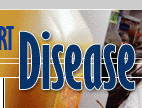Click here to go back.
DANGERS IN GENERALIZING FROM ANIMAL TO HUMAN
Billions of tax dollars pay for these experiments, yet 4,000 people have heart attacks every day. Clearly, animal experiments are not providing the useful and valid information we need. The previous section, "Drug Testing on Animals,” conveys the human health risks associated with the pharmaceutical industry. Here we examine other experiments and their effects.
Heart-lung transplants were successfully achieved in animals, but when this procedure was conducted on humans, the first three patients died. Of the 28 patients undergoing this procedure in a five year span, eight died, and ten developed a lung complication not seen in the experiments on dogs. Of these ten people, four died and three never breathed on their own again. This lung complication was afterward found to be the most important risk of the operation, and was found through human experience. The failure of the animal experiments to warn of this risk caused human deaths.
Animal experiments did not show the link between coronary artery disease, our nation’s #1 killer, and a high cholesterol/high fat diet, because this causal relationship is exclusively seen in humans. For years people sustained their unhealthy eating habits with a false sense of security. Scientists are unable to reproduce this effect in animals, but instead of focusing on humans, they are now trying to genetically alter animals in order to have “the perfect model.” The fact that animals need to be “improved” demonstrates their lack of scientific relevance. With hundreds of thousands of people dying from coronary artery disease every year, perfect models for study are plentiful.
Now commonly performed procedures, heart valve replacements and pacemakers, were delayed because the dogs for whom they were designed developed a complication that is not seen in humans. Animal experiments disrupted heart bypass development, almost keeping this life-saving surgery from humans. Had human research been conducted, these procedures would have been available sooner, thus saving more lives.
The medical community is aware of the limitations of animal experiments. Medical journals reveal quotes by doctors admitting the shortcomings of animal-based tests:
“There is no one perfect animal model that commonly replicates the stages of human atherosclerosis.” 1
“Much of the experimental animal work on atheroma has held back our progress rather than advancing it.” 2
“… any in vitro method using human tissue gives a degree of
reassurance not provided … by animal experiments.” 3“… canine coronary arteries with endothelium relax to acetyl choline, whereas contractions are seen in other species such as the sheep, pig and cattle.” 4
“… vascular grafts placed in humans do not spontaneously form an endothelial monolayer … many animal models have a tendency to spontaneously form an endothelial monolayer …” 5
“In fact, many animal models of vascular graft function are ‘doomed to success’… the principal question centers more around whether these laboratory observations bear any relevance to human(s).”6
1 Thomas M. A. Bocan, Parke-Davis Pharmaceuticals, "Animal models of atherosclerosis and interpretation of drug intervention studies, " Current Pharmaceutical Design (4)1 (1998): 37-52.
2 Medical News Tribune, (18 September 1970)
3 J Nutrition 121 (1991): 431-437
4 Drs. T Luscher & P M Vanhoutte, Mayo Clinic, USA and Basle University Hospital, Switzerland, Trends in Pharmacological Sciences Vol 9 (1988): 181-184.
5 Drs. Stuart K Williams & Bruce E Jarrell, Department of Surgery, University of Arizona Health Sciences Center, Nature Medicine Vol. 2 (1996); 32-34.
6 Williams & Jarnell, 32-34.







